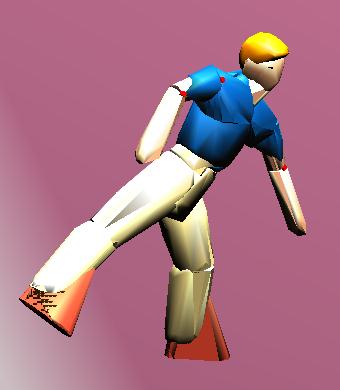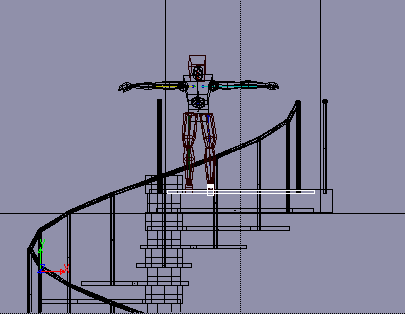

Copyright (c) 1999 John Nagle / Animats. All Rights Reserved
Each purchased copy of the software gives you the right to run this program on ONE machine only. If you need extra copies, please contact Animats to purchase them. Quantity discounts are available. Running a single copy of the software on more than one machine will be considered a copyright violation, and Animats will take appropriate action.
If you install the software on a file server, so that it can be used by multiple computers at one time, you must buy as many copies of the software as could potentially be run simultaneously from the file server copy. Ordinarily, this number will be equal to the number of softimage|3D licenses you have purchased from Softimage.
You can make backup copies of the software as part of
your ordinary file backup procedures. Making copies for other purposes
is prohibited.
Because of the nature of the animation industry, we make
this exception: you may, in a business emergency, make and use additional
copies of the software provided that you 1) have already paid for at least
one copy of the software, 2) contact Animats within 72 hours of so doing,
and 3) pay the normal retail price + 10% for each additional copy you made.
This provides you with some flexibility in a production crunch.
Installing this version will overwrite the previous version of Falling Bodies. If you have to go back, you can re-install an older version of Falling Bodies, and this one will be overwritten.
To "Uninstall", proceed as for "Install", but when presented with "Install" and "Uninstall" buttons, click on "Uninstall".
The user interface is exactly the same as before, but now, Falling Bodies pays attention to animation in the scene.
Several restrictions apply to background objects animated in the scene:


Falling Bodies automatically constructs a simplified, polygon-reduced model of your character for use during simulation. Unlike other systems, the user does not have to hand-build simplified geometry just for dynamics. The pictures above illustrate this process. Each skeleton component (joint, null, or other model) with attached skin is treated as a rigid body, using the skin vertices weighted to that skeleton component. The result is a low-resolution model of the character, as seen in the first figure. The second is a mental ray rendered image of the same character. The low-resolution model is internal to Falling Bodies; you don't have to deal with it and it won't clutter up your Softimage scene.
Both local and global envelopes are supported. The example above used a separate local envelope for each major body part.
When working with flexible envelopes, Falling Bodies adds a small box-like body at each joint's center of rotation. These appear as small red cubes. This ensures that all skeleton parts have some mass, since massless moving parts can't be simulated. Normally, these cubes are hidden inside the model. If you see them, your joints are very near or outside the surface, which may indicate incorrect anatomy.
More technically, Falling Bodies builds its collision model automatically, using the weights of the envelope vertices. Any vertex weighted more than 50% to a skeleton is assigned to that skeleton for collision purposes. All the vertices of a model assigned to a skeleton are then "shrink-wrapped" (the technical term is "convex hull") to create a rigid polyhedral object used internally within Falling Bodies. This collision model is polygon reduced to maintain a 1% accuracy relative to the height of the character. The speed of Falling Bodies simulations is thus nearly independent of the the complexity of the original envelope.
This feature can also be used to fake some kinds of soft body dynamics. While Falling Bodies is a rigid body simulator, models can be built which look soft, by building an envelope around an IK chain. See our "noodle" example.
 If
a simulation can't be started or fails because of errors, the models involved
are selected and appear in white. In this example, the foot is inside the
stair step, which prevents simulation. Error messages from Falling Bodies
appear in the status bar and Softimage status log as usual. Click on the
"Mode" bar at the bottom of the Softimage screen to display recent messages.
If
a simulation can't be started or fails because of errors, the models involved
are selected and appear in white. In this example, the foot is inside the
stair step, which prevents simulation. Error messages from Falling Bodies
appear in the status bar and Softimage status log as usual. Click on the
"Mode" bar at the bottom of the Softimage screen to display recent messages.
Falling Bodies detects collisions between the body parts of the character, so that, for example, arms won't pass through legs. Overlap between two models connected to the same joint is allowed, so smooth joints at elbow, knee, and hip are possible without requiring a gap. The user should set joint limits (with Motion-Constraint-Rotation Limits) to prevent joints from moving too far. These simple rules take care of most collisions between body parts.
Collisions between the inner thighs, where there is little or no clearance, can be a problem. Vertices weighted to the wrong skeleton object in this area may cause Falling Bodies to report that there are initial collisions it can't handle. The easiest way to fix this is to weight vertices in the crotch area to the parent of the leg chains (usually the torso). Overlap between the torso and each upper leg is allowed, but overlap between the legs is not. So weighting vertices to the torso is safe; that body area can then overlap with either leg without complaint from Falling Bodies.
It's also possible to have problems with characters where the arm models extend inward to the base of the neck and collide with each other, or with the base of the neck. Moving the chain roots for the clavicle joints outward from the base of the neck will fix this.
The Softimage physical property "Density" is currently ignored by Falling Bodies. There were problems in Softimage|3D 3.7 reading this value from a plug-in. Elasticity and roughness are understood by Falling Bodies. Density is fixed at 1.0.
Messages of the form "SI_ERROR: Model does not have any Physical Properties" will appear in the Softimage|3D console window when models with no physical properties are in the scene. This is harmless, but unavoidable with the current plug-in support in Softimage|3D. Falling Bodies will use default values and proceed.
Density is currently fixed at that of water, 1.0gm/cm2.
The system is self-tuning; there are no manual parameters to set. Internally, the height of the character (with limbs extended) is used as an scale factor where one is needed within the system. In general, errors are held to under 1% of that height. Characters from cat size up to Godzilla size should work effectively. Insect-sized characters are not well-supported. (At insect scale, viscosity and surface tension, rather than gravity and inertia, dominate, so a different sort of simulator would be needed.)
Models are allowed to interpenetrate slightly. This is a reasonable assumption for human bodies; we call it "skin thickness". It gives bouncing bodies more realistic motion than other approaches which allow no overlap. Currently, "skin thickness" is computed based on the dimensions of each model and is not adjustable by the user. Models will never penetrate beyond the "skin thickness". Nor will bodies "fall through the floor", as with certain other systems.